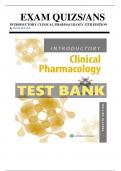Exam (elaborations)
Introductory Clinical Pharmacology 12th Edition Test Bank by Susan Ford Chapters 1-54| Latest Practice Exam 100% Verified Answers
- Course
- Institution
- Book
***Download Test Bank Immediately After the Purchase. Just in case you have trouble downloading, kindly message me, and I will send it to you via Google Doc or email. Thank you*** Access the comprehensive test bank for 'Introductory Clinical Pharmacology 12th Edition by Susan Ford.' Covering chapt...
[Show more]



